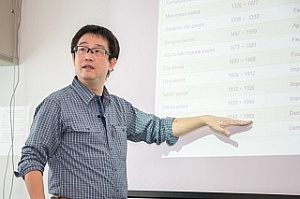In 2016, the management of TSU and the leading university of Japan - the Tokyo Metropolitan University agreed to hold an annual joint symposium on urban studies, on the basis of which a research group with the participation of experts from Europe will be formed. Scientists study Japanese, Siberian, and European cities together, discuss their development, transformation, and modernization.
As a part of this symposium Daiichi Nakayama, Associate Professor of Tokyo Metropolitan University gave a course of lectures for students of Biological Institute and the Faculty of Geology and Geography in which special emphasis is placed on modeling and forecasting of natural disasters (volcanic eruptions, earthquakes) using GIS technologies.
1) On March 2011, a huge earthquake occurred in the eastern maritime of Japan. This type of earthquakes has been occurred due to oceanic plates subduction under continental plates. Japan locates on the convergent boundary of three or four plates, and this causes frequent earthquakes.
In this lecture, we talk about earthquakes in Japan, its countermeasure, and our recognition of earthquakes.
2) The winter of the north-west side of Japan (the Japan Sea side) has much snowfall in contrast with less snowfall in the south-east side of Japan (Pacific Ocean side). This difference is connected with the north-western monsoon which blows from Siberia in winter.
In this lecture, we talk about the mechanism of Japanese winter and its effect on Japanese life from natural aspects.
3) Japan has more than 200 volcanoes and we, Japanese, have been living with volcanoes for several thousand years. For people from Japan, volcanoes are recognized as not only natural phenomenon but also a part of our history, culture, and religion.
This lecture explains the change of Japanese perception of volcanoes from natural and historical aspects.
4) Sagamihara area (western part of The Greater Tokyo Area, 10km west of TMU) has three fluvial terraces and the difference of their groundwater storage have caused the land use variation on the terrace surfaces. This also shows that the life of residents has been affected by the local water environment.
In this lecture, we introduce the difference between land use and lifestyle of terrace surface from geomorphological and historical aspects.

